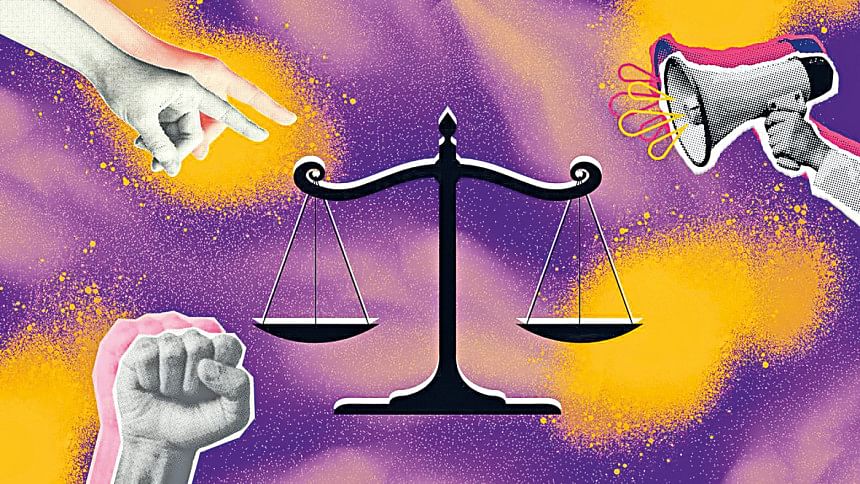Unravelling Bangladesh’s Constitutional Conundrum

The principles of 'equality before law' and 'equal protection of law', cornerstones of modern constitutionalism meant to ensure fairness and justice for all citizens, are entangled in a web of conceptual and judicial inconsistency.In Bangladesh, these principles are enshrined in Article 27 of the Constitution. Yet, the judicial interpretation and practical application of these distinct, though related, concepts have been fraught with confusion, highlighting a broader conceptual deficiency within the legal fraternity. This ambiguity has taken on renewed urgency in the wake of the July-August 2024 mass-uprising, where protests against inequality and state repression underscored the dire consequences of failing to uphold constitutional guarantees. Now, the question remains: can Bangladesh uphold its constitutional promise of equality, or will these fundamental rights continue to be obscured by legal ambiguity?
The recent recommendation by the Constitution Reform Commission to amend Article 27 and expand 'equal protection of law' to include 'equal protection and benefit' has added to the existing confusion and complexity. While well-intentioned, the inclusion of 'benefit' is superfluous, as entitlement to the law's benefits is already implicit in the rule of law—a principle deeply intertwined with equality. As Lord Bingham articulated in The Rule of Law, its essence is that everyone is bound by and entitled to the benefit of law. Explicitly adding 'benefit' risks creating further ambiguity and obscuring the distinct functions of the two limbs of equality.
To truly uphold Bangladesh's constitutional promise of equality, the judiciary must adopt a coherent approach and rigorously differentiate between these two principles, ensuring robust safeguards against arbitrary power and drive substantive equality.
To fully grasp the implications of 'equality before law' and 'equal protection of law', their historical and conceptual roots must be examined. 'Equality before law' finds early articulation in the Magna Carta, a landmark medieval document sealed in 1215 between King John of England and his barons. King John, known for his arbitrary rule, heavy taxation, and disregard for his subjects' rights, faced rebellion. The Magna Carta established that even the monarch was subject to the law, declaring that all citizens, regardless of status, should be ruled fairly and equally. This idea was further developed by AV Dicey, who defined it as the equal subjection of all individuals to ordinary laws administered by ordinary courts, preventing arbitrary power. Over time, its interpretation has focused on the impartial application of laws, ensuring procedural fairness and guaranteeing that all individuals, regardless of status, are subject to the same legal treatment.
Conversely, 'equal protection of the law' originates from the Fourteenth Amendment to the US Constitution. Initially focused on preventing racial discrimination, its interpretation has broadened to address various forms of discriminatory treatment. Unlike 'equality before law', which focuses on uniform application of law to prevent arbitrary enforcement, 'equal protection of the law' mandates that legislation is non-discriminatory and requires the state to take positive steps against discrimination. While the former embodies a negative approach, and the latter takes a positive approach, their primary aims remain fundamentally distinct: 'equality before law' primarily targets judiciary and executive actions in applying the law, whereas 'equal protection of the law' targets the legislature in enacting laws.
However, the Supreme Court of Bangladesh has significantly blurred the conceptual boundaries between these two principles through a series of judicial missteps. Firstly, the Court consistently employed interchangeable definitions, conflating the two principles. The concept of 'treating similarly situated individuals alike', central to 'equal protection', was misapplied to 'equality before law', which focuses on preventing arbitrary legal distinctions. In Sontosh Kumar Saha, this conflation peaked with the assertion that 'equal protection of law means all persons are equal in all cases', ignoring the principle's allowance for differential treatment to achieve genuine equality. Secondly, the Court failed to establish a clear framework distinguishing the purposes and applications of each principle, leading to overlapping and contradictory interpretations. Thirdly, the Court's overemphasis on the 'similarly situated' criterion, relevant to 'equal protection', neglected 'equality before law', prioritising substantive equality over non-arbitrary legal application. Finally, later cases like Bangladesh v Md Azizur Rahman and Md Nur Hossain v Bangladesh reinforced this conflation by reiterating flawed interpretations, cementing a judicial precedent that erases the distinction between these two facets of equality.
Bangladesh's equality interpretation must align with international standards, reflecting principles it has agreed to uphold. Article 26 of the International Covenant on Civil and Political Rights, to which Bangladesh is party, enshrines 'equality before the law' and 'equal protection of the law'. Nowak clarifies these principles, stating that 'equality before the law' emphasises the enforcement of existing laws, requiring impartial application by judges and administrators, rather than absolute identical treatment. It mandates equal treatment for objectively equal situations and unequal treatment for unequal ones. This principle primarily focuses on the judiciary and executive, ensuring non-arbitrary application, distinct from 'equal protection of the law', which primarily addresses the legislature's duty to enact non-discriminatory laws. This distinction, endorsed in cases like Kavanagh v Ireland and O'Neill and Quinn v Ireland, remains ignored in Bangladesh.
The evolving interpretation of equality within Bangladesh's constitutional landscape highlights the persistent difficulty in maintaining distinct meanings for 'equality before law' and 'equal protection of law'. The repeated invocation of 'like should be treated alike' to define both concepts has led to the erosion of their individual normative purposes. This trend is, however, not unique to Bangladesh. Even the Indian Supreme Court, eg, in Srinivasa Theatre v Government of Tamil Nadu, acknowledged their commonality, despite distinct meanings. Similarly, the US Supreme Court's experiences, including with Dred Scott and Plessy, illustrates struggles with equal protection, notably the 'separate but equal' doctrine. Only in Brown v Board of Education did the Court conclusively hold segregation unconstitutional, affirming that separate educational facilities are inherently unequal.
To truly uphold Bangladesh's constitutional promise of equality, the judiciary must adopt a coherent approach and rigorously differentiate between these two principles, ensuring robust safeguards against arbitrary power and drive substantive equality. This precision will enhance access to justice, strengthen the rule of law, and transform the cries of the masses into a reality of justice for all.
The writers are Lecturer in the Department of Law at ZH Sikder University of Science and Technology, and Assistant Professor and Chair in the Department of Law at ZH Sikder University of Science and Technology, respectively.

 For all latest news, follow The Daily Star's Google News channel.
For all latest news, follow The Daily Star's Google News channel. 



Comments